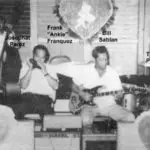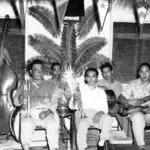Francisco G. Franquez


Francisco Garrido Franquez (1921 – 2006), also known as “Frank” or “Ankie,” first picked up the harmonica at the age of 14 years old. In 1935 or 1936 there was a harmonica contest in the Guam schools for students throughout the island. Though Franquez did not care for the instrument at first, he continued to practice and eventually became an accomplished player.
Franquez’s uncle recognizing his talent for playing the instrument, encouraged him to enter the contest and was so enthusiastic about his nephew’s talent that he awakened Franquez in the middle of the night to play for him. Through the encouragement of his uncle and the use of a phonograph and records as a “tutor,” Franquez continued to play the harmonica and nurture his growing talent.
During the Japanese occupation of Guam from 1941 to 1944 during World War II, occupying forces forbade the playing of American music. Franquez, however, and many of his friends and future band mates would practice playing American music in a makeshift chapel during the occupation. When caught by the Japanese the musicians would say the music was part of their prayer ritual. With Franquez as the leader with his harmonica, the small band consisted of a guitar player, a bass player and a piano player.
Franquez and his band mates continued to play after the war. They played at numerous gatherings including village fiestas. They soon caught the attention of military personnel new to Guam and landed a gig at Fiddlers Green at Naval Air Station, Tiyan, in the early 50s. Word of their talent soon spread and chiefs from various military posts on the island including Naval Magazine, Naval Station, and Naval Communications Station were eager to hire Franquez and his group. Many Americans were impressed with Franquez’s familiarity with American music, as well as his ability to play popular music that was composed before Franquez was even born.
Franquez would later use his talent to teach other musicians. During the 60’s Franquez frequented the “Lanchon Antigo,” a social activities center for the elderly, in Inalåhan. By this time, all of the musicians Franquez had originally played with had passed away. It was in Inalåhan where Franquez met Maria (Nenita) Palacios whom he taught the jazz standards and how to play the organ. Palacios would go on to become an accomplished musician and, with Franquez, would play music for many years until her death.
Franquez received a Maga’lahi Award from Guam Council on the Arts and Humanities Agency (CAHA) in 1999.
Franquez is married to Cecelia Franquez, and they have seven children. Two of their children, Frankie and Joey, have followed in their father’s footsteps becoming accomplished musicians and studying music in college.
Editor’s note: The photos and initial research for this entry is courtesy of Mico and Stevie Scott’s Jazz on Guam: An Oral History, a project funded by the Guam Humanities Council and in part by the National Endowment for the Humanities.
